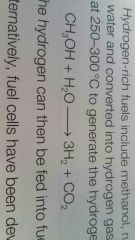![]()
![]()
![]()
Use LEFT and RIGHT arrow keys to navigate between flashcards;
Use UP and DOWN arrow keys to flip the card;
H to show hint;
A reads text to speech;
36 Cards in this Set
- Front
- Back
|
Lattice enthalpy |
The formation of one mole of an ionic compound from its gaseous ions under standard conditions. |
|
|
Enthalpy change of formation |
When one mole of a compound is formed from its elements in their standard states under standard conditions |
|
|
Why can lattice enthalpies not be measured directly? |
It is impossible to form an ionic lattice from gaseous ions experementally, especially under standard conditions |
|
|
The standard enthalpy change of atomisation |
One mole of gaseous atoms form from the element in its standard state |
|
|
First ionisation energy |
The removal of one electron from every atom in one mole of gaseous atoms, forming one mole of gaseous 1+ ions. |
|
|
Second ionisation energy |
The removal of one electron from every ion in one mole of gaseous 1+ ions, forming one mole of gaseous 2+ ions |
|
|
First electron affinity |
Addition of one Electron to every atom in one mole of gaseous atoms, forming 1 mole of gaseous 1- ions |
|
|
Why is lattice enthalpy an exothermic change? |
Energy is given out when bonds are formed from gaseous ions. |
|
|
Why is atomisation endothermic? |
Energy is required to break bonds |
|
|
Why are ionisation energies endothermic? |
The electron being lost needs to overcome attraction from the nucleus to leave the atom/ion |
|
|
Why is the first electron affinity exothermic? |
The electron is attracted into the outer shell of the atom by the nucleus |
|
|
Why is the second electron affinity endothermic? |
The second electron is repelled by the 1- ion which requires energy to overcome. |
|
|
What equation can be used to calculate unknowns in born Haber cycles? |
Enthalpy change of formation = sum of all other enthalpies |
|
|
Standard enthalpy change of solution |
When one mole of a compound is completely disolved in water under standard conditions |
|
|
What two processed occur when a solid disolves in water? |
The ionic lattice is broken down into gaseous ions Hydration of the ions |
|
|
How are the gaseous ions in an ionic compound hydrated? |
The negative ions bond with the positive hydrogen and the positive ions bond with the negative oxygen |
|
|
Enthalpy change of Hydration |
When one mole of of isolated gaseous ions are disolved in water forming one mole of aqueous ions under standard conditions |
|
|
What formula can be used to calculate unknowns when dealing with enthalpy change of solution? |
Lattice enthalpy + enthalpy change of solution = enthalpy change of Hydration of the ions |
|
|
Why do smaller ions have more exothermic values of lattice enthalpy? |
Because they can pack closely together so there is a stronger attraction |
|
|
Entropy, S |
The quantitative measure of the degree of disorder in a system |
|
|
How can you calculate the entropy change of a reaction? |
Entropy change of the products - entropy change of the reactants |
|
|
Free energy change 🔺G |
🔺G=🔺H- T🔺S |
|
|
When can a process occur spontaneously? |
When delta G is smaller than zero |
|
|
Oxidising agent |
Substance which is reduced |
|
|
Reducing agent |
Substance which is oxidised |
|
|
How is current transfered through the wire and also through the salt bridge in a electrochemical cell? |
Wire - electrons Salt bridge - ions |
|
|
A simple salt bridge can be made by soaking a strip of filter paper soaked in an aqueous solution of an ionic compound which does not react with either of the half cells. Give two examples of solution which could be used. |
KNO3 or NH4NO3 |
|
|
Standard electrode potential |
The e.m.f. of a half cell in comparison to a standard hydrogen half cell, measured at 298K with solutions of concentration 1moldm^-3 and a gas at 1 atmosphere |
|
|
Four reasons why a redox reaction may not occur? |
The reaction may not occur under standard conditions. If the cell potential is less that 0.4 High activation energy Slow rate |
|
|
3 examples of rechargeable cell |
Nickel and cadmium (Ni-Cad) Lithium-ion Lithium polymer |
|
|
How do methanol fuel cells work? |

The methanol is reacted with a reformer on board which produces hydrogen. This is then used as fuel for the cell. |
|
|
Two advantages of fuel cells |
Less CO2 produced They are more efficient |
|
|
Three ways to store hydrogen |
As a liquid under pressure Adsorbed onto the surface of a solid Absorbed within a solid |
|
|
Three limitations of hydrogen fuel cells |
Hydrogen is hard to store The fuel cells themselves have a limited lifetime Fuel cells use toxic chemicals in their production |
|
|
How to produce hydrogen |
Electrolysis of water Reaction of methane and steam |
|
|
One difference between a fuel cell and a modern storage cell |
Fuel cells require constant fuel to run and an oxidant |

